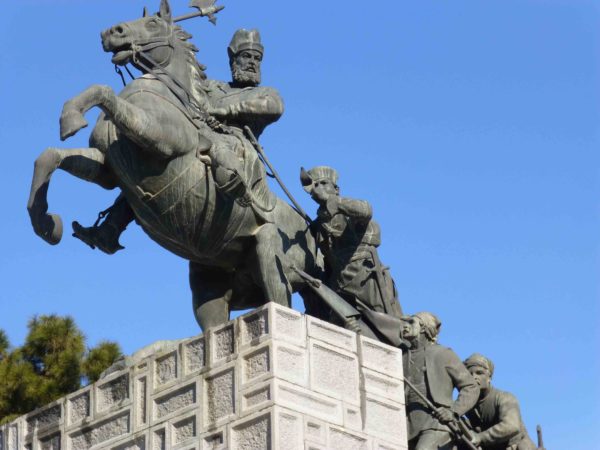Arriving by plane the first view of the city is that of a very green and well-laid regular rows of trees. Once on the ground, the traveler is fascinated by the golden cupolas and minarets. It is interesting to know that the word of Mashhad - or more correctly Mashhad-e Moqaddas (Mashhad the Holy) - literally means place of martyrdom (or place of burial of a martyr).
Nowadays, apart from being the holiest city of Shi'ite Iran, Mashhad can boast of hundreds of thousands of pilgrims from all over the world, including Yemenis, Iraqis, Indians, but primarily Afghans and Pakistanis, the two latter comprising on that account alone the vast majority of all foreign tourists in the region.
Shrine of Imam Reza:
Mashhad grew around the legendary martyrdom of Imam Reza, and the city's history is inextricably linked with that of his Shrine. According to popular belief, Imam Reza, heir to the Abbasid Caliphate as well as eighth of the Shiite Imams, died in what was then the village of Sanabad in 817 AD after eating some grapes. The story spread that he had been poisoned on the orders of the Caliph Ma'mum after having in some way arousing his enmity. Whatever the truth, Ma'mum buried him in a tower in Sanabad next to the tomb of his own father, the famous Harun or-Rashid, and in time this burial place began to attract Shi'ite pilgrims. What had been a small village grew around the Shrine into small town, later known as Mashhad, but for many centuries its development was slow and until much later it remained a pilgrimage center of only regional importance.
Gowharshad Mosque:
Grand Mosque of Gowharshad (Masjid-e Azim-e Gowharshad) with its 50-meter high faience dome and cavernous golden portal, is located immediately to the south of the Holy Shrine of Imam Reza square and is architecturally perhaps even more important than the mausoleum. Queen of a mighty empire, wife of Tamerlane's eldest son Shahrokh, patron of the arts and powerful personality in her own right, Gowharshad was one of the most remarkable women of Islamic history. Although most of her major architectural commissions were at her capital Herat, this mosque in Mashhad is the best preserved testament to her genius. She built this beautiful mosque between 1405 and 1418: though within the shrine's precincts it is technically and legally separate. It covers an area of 9419 square meters, and has two beautiful minarets each 40 meters high. An inscription can be seen on the margin of the ivan portal, which was partially made upon the orders of well-known Timurid prince called Baysonqor Mirza. Also there is a pulpit of walnut wood here, which has been made without making use of any nail or iron pieces. Sir Percy Sykes, soldier, diplomat and historian, describes it as "the noblest mosque in Central Asia", and A U Pope as "the first and the greatest surviving Persian monument of the 15th century." The facade of its four-ivan court is decorated with brilliant mosaic tiling of the highest quality; the two stories of the arcaded rooms round the court are used for religious teaching and gathering. Behind the ivan can be see the Shrine's golden dome and the two superb minarets.
Bazaars of Mashhad:
Mashhad has three bazaars. The biggest, the two storied Bazaar-e Reza (or Bazaar-e Bozorg), is 800 m long, 30 m wide, and one of the main shopping centres in the town. The crafts of Khorassan are all represented in the bazaar. All kinds of local souvenirs such as fur-cloak, turquoise, Carnelian ring, gold, perfume, saffron, pelisse, prayer-mat, and rosary may be found here besides a myriad of foreign articles. There are several escalators in the Bazaar, which take the visitors to the second floor. The bazaar has two gates: one in Bayt ol-Moqaddas Square and the other in the 17th Shahrivar Square. The next shopping centre is called Sara-ye Bazaar-e Reza, where products such as embroidery, knitwear, shoes, etc, are sold. The third bazaar, called the Kuwaiti Bazaar, is situated in the 17th Shahrivar Square, where various categories of products are sold. Make sure also to visit a workshop where turquoises from the Neishabur mines are cut and polished. Bazaar is open 8 am to 8 p.m., SaturDay to ThursDay. The remains of several old caravansaries, now put to other purposes, can be seen. Postal services are provided at both ends of Bazaar-e Reza during the office hours.
Certain other shopping centers are scattered in the town: 1) Zist-e Khavar Business Centre, in Dr Shari'ati Square (Kuh Sangui) affiliate with Bank-e Tejarat, and in building considered the most attractive and the most spectacular shopping centre in the Middle East; and 2) Shops along Ahmad Abad Ave, Jannat Ave, Daneshgah Ave, and Modarres Ave.
The Nader Shah Mausoleum:
The Nader Shah Mausoleum (in Shohada Street, beginning of Azadi Street) is a curious piece of architecture completed in 1959, consisting in a heavy slab of concrete which forms a crypt and of a colossal bronze group representing soldiers led to battle by a sort of an equestrian commander on horseback (5 meters high and weighing 14,000 kilograms) bearing a turban and a large ax (Nader Shah). Designed by the late Iranian sculptor Abolhassan Sadiqi (1897-1995, a follower of the Master Painter Kamal ol-Molk) and built in Italy by an Italian sculptor named Bruni, the composition does not lack movement. The crypt shelters the tomb of Nader Shah, who made Mashhad his capital and operational base for his campaign against India. A small museum and a library have been set up nearby: Nader Shah souvenirs, mainly 18th and 19th century weapons, helmets and armor (altogether 130 pieces, from Afshar period), and prehistoric bronze objects unearthed during excavations in the region. It is open daily from 7:30 a.m. to 12:30 p.m. and from 2 to 4:30 p.m., except Friday. Tel: (051) 24888.
Finally, if you like to visit Mashhad, have a look on our tours and select your favorite itinerary.
